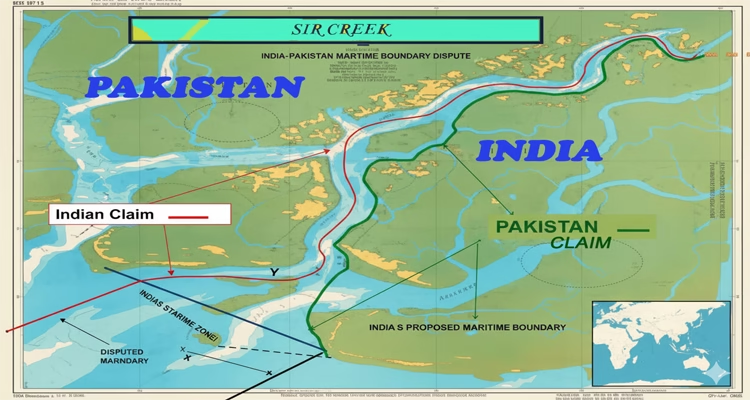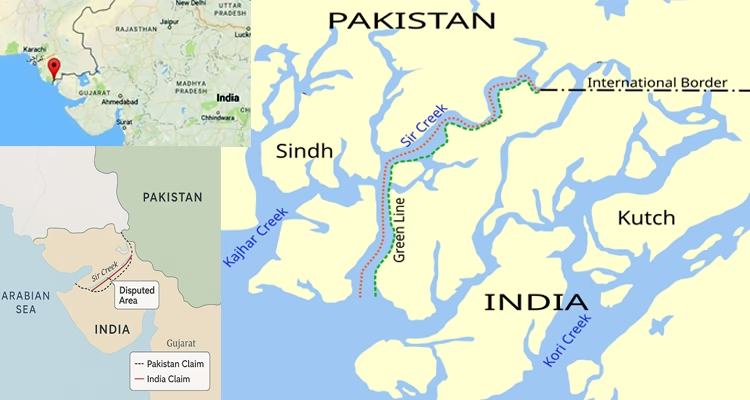Sir Creek Dispute — A Strategic Flashpoint in India-Pakistan Relations
Amid the salt flats and marshes of the Rann of Kutch lies Sir Creek — a narrow, 96-kilometre tidal estuary that has quietly fueled one of South Asia’s longest-running border disputes. What appears to be a sliver of water between India and Pakistan is, in reality, a potential game-changer for regional strategy, resources, and security.
Historical Roots of the Dispute
The origins of the Sir Creek dispute go back more than a century. In 1914, the Sindh government (then part of British India) and the ruler of Kutch signed a resolution drawing the boundary along the eastern bank of Sir Creek.
After Partition in 1947, Pakistan inherited Sindh and began claiming the entire creek up to its eastern edge. India, however, holds that the border runs along the mid-channel of the creek, following the thalweg principle of international law — which fixes boundaries along the deepest part of navigable channels.
The dispute simmered for decades and flared again after the 1965 Indo-Pak war. A UN tribunal later settled most of the Rann of Kutch border issue, but Sir Creek remained unresolved. Despite several rounds of talks, both countries continue to hold conflicting maps — and firm positions.
Strategic and Economic Stakes
Sir Creek’s real importance lies beneath and beyond its muddy waters.
Geologists believe the area could hold untapped oil and gas reserves. The creek also determines the demarcation of the Exclusive Economic Zones (EEZs), which decide each nation’s maritime rights over fishing, seabed resources, and offshore drilling.Strategically, control over the creek means influence over a crucial stretch of the Arabian Sea, through which both naval and commercial routes pass. For India, it’s about maritime sovereignty; for Pakistan, it’s the first line of defence for Karachi — its biggest port and economic lifeline.
Rajnath Singh’s Stern Warning
On October 2, 2025, Defence Minister Rajnath Singh reignited the debate with a blunt message to Pakistan. Speaking at the Bhuj Military Station in Gujarat during Vijaya Dashami celebrations, Singh warned Islamabad that any provocation around Sir Creek would invite a response that could “rewrite history and geography.”
He stressed that “the road to Karachi passes through the creek,” a remark seen as both symbolic and strategic — reaffirming India’s readiness to defend its maritime borders.
Officials say the warning followed intelligence reports of Pakistan’s increased military activity in the area, including the construction of new bunkers and observation posts around Harami Dhoro and Bandha Dhora.
Analysts note that Singh’s statement served two purposes — sending a deterrent signal to Pakistan, and assuring the domestic audience of India’s strong security posture.
Pakistan’s Response and Ground Activity
Pakistan, meanwhile, has not remained idle. Reports indicate it has been strengthening its coastal defence network near Sir Creek, expanding patrol operations, and upgrading infrastructure to support maritime surveillance.
In response to Singh’s warning, the Pakistan military condemned India’s “provocative remarks,” claiming they were “unhelpful for regional stability.” Yet Islamabad continues to insist that the eastern bank marks the rightful border — a claim India rejects under the thalweg principle.
Pakistan has also floated the idea of international arbitration, while India maintains that the matter should remain bilateral, in line with the Simla Agreement.
Why Sir Creek Still Matters
Despite its small size, Sir Creek carries massive implications. Control over it defines maritime boundaries, resource zones, and even regional influence. For Pakistan, the creek guards the approach to Karachi. For India, it represents the assertion of national sovereignty and strategic depth in the Arabian Sea.
As one defence analyst put it:
“Sir Creek isn’t just a creek — it’s a test of resolve. Whoever controls it controls a gateway to the sea.”
The Road Ahead
With both sides firm on their claims, the Sir Creek issue remains in diplomatic deadlock. Occasional talks have failed to yield progress, and the shifting geography of the creek — shaped by tides and silt — only complicates matters further.
While neither nation seeks open conflict, growing militarization and rising rhetoric have made Sir Creek a sensitive flashpoint once again. A durable solution will require constructive dialogue, respect for legal principles, and mutual restraint.
Until then, the silent waters of Sir Creek will continue to ripple through India-Pakistan relations — a reminder that even a thin line on a map can carry the weight of history, pride, and power.





